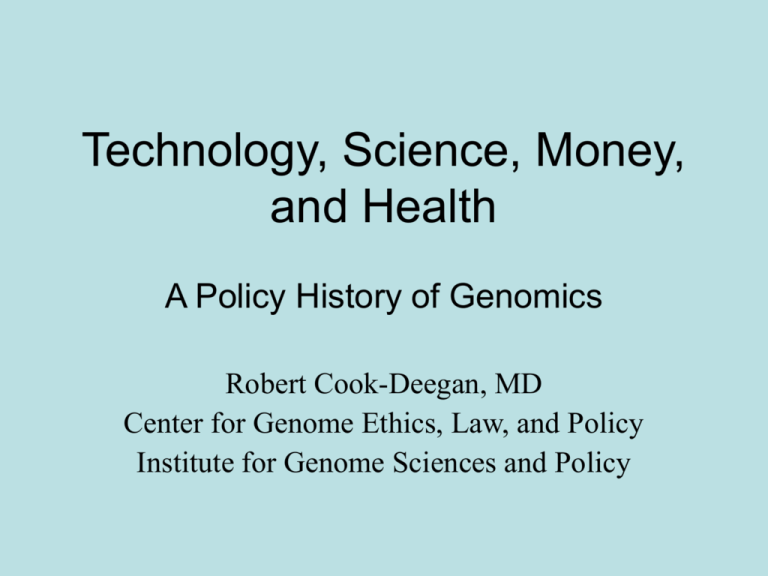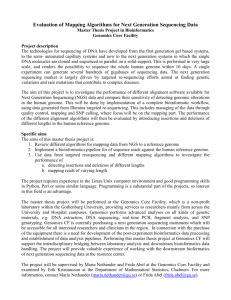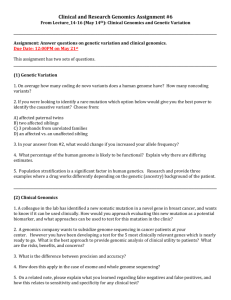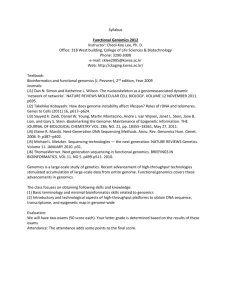Technology, Science, Money, and Health
advertisement

Technology, Science, Money, and Health A Policy History of Genomics Robert Cook-Deegan, MD Center for Genome Ethics, Law, and Policy Institute for Genome Sciences and Policy Outline of the talk • • • • • • Some histories Some data Some interpretation Some stories A few more data Some interpretation Technology 1973 1975-7 1981 1983 1986 1989 1995 1996 2001 Recombinant DNA DNA sequencing Desktop PC (1984 Macintosh) PCR (1986 Cold Spring Harbor talk) Automated DNA sequencing World Wide Web Micro-arrays SNPs (1999 SNP Consortium) Haplotype map (2003 officially launched) Science • • • • • • • • • 1950s Phage group 1960s Emergence of molecular biology 1970s Dominance of molecular biology 1980s Scale-up of molecular biology 1990s Capital-intensive biology 2000 Draft sequence 2003 Reference sequence 2004 Genetic variation Next? Integration with organismal biology and clinical research (beyond lip service?) Policy issues • 1985-88 To fund or not to fund – Big Science v cottage industry – Human genetics or worm-yeast sociology • 1989-1993 Launch phase – Getting maps done – NIH-DOE leadership competition; international collab. • 1993-2003 Public-private competition – Sequencing • 2004 Making information useful ELSI priorities • Early – Genetic discrimination, genetic privacy – Transition from gene discovery to genetic test – Eugenics history • Middle – Health professional education – Regulation of tests, “screening” use • Newer – Race, diversity, health disparities – Intellectual property • Next – Reimbursement, coverage, cost, cost-effectiveness Money • 1940 Industry > philanthropy > gov’t • 1950-60 Fed > industry > philanthropy • 1990 Industry > fed > philanthropy • 19976-80 first wave of biotech startups • 1981 Applied Biosystems founded • 1992-3 first wave of genomics startups – Incyte, Human Genome Sciences, Millennium, Mercator, Myriad, etc. • 1998 Celera • 2000 peak of genomics bubble • 2004 continued R&D increases, but market cap decline 1940 1941 1942 1943 1944 1945 1946 1947 1948 1949 1950 1951 1952 1953 1954 1955 1956 1957 1958 1959 1960 1961 1962 1963 1964 1965 1966 1967 1968 1969 1970 1971 1972 1973 1974 1975 1976 1977 1978 1979 1980 1981 1982 1983 1984 1985 1986 1987 1988 1989 1990 1991 1992 1993 1994 1995 1996 1997 1998 1999 2000 2001 2002 2003 NIH Appropriations 1940-2003 30 25 20 15 $ billion (2000 dollars) 10 5 0 Year S1 National Health Expenditures 1,200 1,000 800 National Health Expenditures (billions) adjusted by Y2000 deflator 600 400 200 00 20 98 19 96 19 94 19 92 19 90 19 88 19 86 19 84 19 82 19 80 19 78 19 76 19 74 19 72 19 70 19 68 19 66 19 64 19 62 19 60 0 19 $ Billion (Y2000 constant dollars) 1,400 20 19 19 19 19 19 19 19 19 19 19 19 19 19 19 19 19 19 19 19 19 00 98 96 94 92 90 88 86 84 82 80 78 76 74 72 70 68 66 64 62 60 Percent Health R&D as Percent National Health Expenditures 4.00 3.50 3.00 2.50 2.00 1.50 1.00 0.50 0.00 Health Research Funding 1940 7% 1965 24% 38% 55% Philanthropy 1998 8% Industry 68% 46% 49% 5% Government Federal Health (budget function 550) v PhRMA R&D 1970-2000 Thousand $ (1996 dollars) 25,000.00 20,000.00 15,000.00 10,000.00 5,000.00 PhRMA NSF pharma Fed Health R&D (550) 00 99 20 98 19 97 19 96 19 95 19 94 19 93 19 19 92 91 19 90 19 89 19 88 19 87 19 86 19 85 19 84 19 83 19 82 19 81 19 80 19 79 19 78 19 77 19 76 19 75 19 74 19 73 19 72 19 71 19 19 19 70 - Intellectual property 1980 Diamond v Chakrabarty 1980 Cohen-Boyer 1980 Bayh-Dole; Stevenson-Wydler 1982 Court of Appeals for the Federal Circuit 1991 EST controversy 1994 Eisenberg-Merges; Varmus abandons EST patents 1995 OTA dies before publishing DNA patenting report 1995 ten-sequence rule 1995 TRIPS 1999 Examination guidelines (utility; written description) 1999 NIH guidelines on research tools 2000 US adopts 18-month publication rule 2004 NIH draft guidelines on patent licensing Which of these histories matters? Scientific, practical, and commercial value of DNA information • Analysis, networking and distributed work through computers and telecomm • Stronger patents • Tighter links between academe and pharma/biotech Which policies mattered? • Health research (and genomics) funding? • Availability of capital for high-tech, whizbang science • Stronger patent protection • Tech transfer policy Translation of Delphion Search Algorithm 1. Search US Patent classes 047 (plant husbandry), 119 (animal husbandry), 260 (organic chemistry), 426 (food), 435 (molecular biology and microbiology), 514 (drug, bio-affecting and body treating compositions), 536/subclasses 22 through 23.1 (nucleic acids, genes, etc., but not peptides or proteins), subclasses 24 and 25 (various nucleic acids, variants, and related methods), and class 800 (multicellular organisms). 2. Select patents from that group that include one or more of the following terms in their claims: antisense cDNA centromere deoxyoligonucleotide deoxyribonucleic deoxyribonucleotide DNA (with or without following letters, such as DNAs) exon gene or genes (exact match only) genetic genome genomic genotype haplotype intron mtDNA (with or without following letters such as mtDNAs)—exact case match only nucleic nucleotide [List of terms continued] oligonucleotide oligodeoxynucleotide oligoribonucleotide plasmid polymorphism polynucleotide polyribonucleotide ribonucleotide ribonucleic recombinant DNA (exact match for case and words only) RNA (all upper case only, with or without following letters such as RNAs) mRNA (exact case match only, with or without following letters such as mRNAs) rRNA (exact case match only, with or without following letters such as rRNAs) siRNA (exact case match only, with or without following letters such as siRNAs) snRNA (exact case match only, with or without following letters such as snRNAs) tRNA (exact case match only, with or without following letters such as tRNAs) ribonucleoprotein hnRNP (exact case match only, with or without following letters such as hnRNPs) snRNP (exact case match only, with or without following letters such as snRNPs) SNP (exact case match only, with or without following letters such as SNPs) Terms were tested for specificity and sensitivity Number of Patents Retrieved by Search Algorithm by Year of Issue 5000 Number of Patents Retrieved by Search Algorithm 4500 4000 3500 3000 2500 2000 1500 1000 500 03 02 20 01 20 00 20 99 20 98 19 97 19 96 19 95 19 94 19 93 19 92 19 91 19 89 90 19 Year of Issue 19 88 19 87 19 86 19 85 19 84 19 83 19 82 19 81 19 80 19 79 19 78 19 77 19 76 19 75 19 74 19 73 19 72 19 19 19 71 0 This research was supported by Grant No. R03 HG02683-02, “DNA Patent Policies at Academic Institutions,” from the National Human Genome Research Institute, NIH, and Grant No. DE FG 02 01ER63171, “Enhancing the DNA Patent Database,” from the U.S. Department of Energy; Io Nami Wolk 02-25-04. Preliminary Data about the 30 Entities Holding the Largest Numbers of DNA-Based Patents (as of 02-05-04) Entity Name 0 University of California United States Government GlaxoSmithKline Incyte Genomics Aventis Chiron Genentech Bayer Wyeth Novartis Merck University of Texas Human Genome Sciences Amgen Johns Hopkins University Applera Massachusetts General Hospital Novo Nordisk Harvard University Pfizer Stanford University Lilly Salk Institute Cornell University MIT Affymetrix Columbia University University of Wisconsin Washington University University of Pennsylvania 100 200 300 Number of DNA-Based Patents 400 500 600 700 Academic Institution 800 Government 900 1000 For Profit Firm This research was supported by Grant No. R03 HG02683-02, “DNA Patent Policies at Academic Institutions,” from the National Human Genome Research Institute, NIH, and Grant No. DE FG 02 01ER63171, “Enhancing the DNA Patent Database,” from the U.S. Department of Energy. Io Nami Wolk 03-03-04 Sir John Sulston and the Open Genomics of the Worm The Worm Project Coming: Rachel Ankeny: The Conqueror Worm Another Story The Third Way Celera: Data by subscription Spectrum of data access • Bermuda rules: 24-hour data release • Merck EST database, cancer Genome Anatomy Program, Mammalian Gene Collection, mouse mutant collections • Apply for patent and abandon: SNP Consortium • Celera: data by subscription • Universities: genes for a license fee • Incyte: high-priced multilateralism • Pharma: publish occasionally • HGS: trade secrecy plus patent Yellow = private R&D $; White = public $ Policy story: cDNA sequencing • Incorporated into OTA budget plan (1987 “costs” workshop) • Omitted from NIH initial 5-year plan 1990 • EST patent controversy 1991 • Incyte, HGS based on cDNA sequencing 1992-3 • Merck EST index 1994-5 • Cancer genome anatomy program, Mammalian gene collection 1996 • Lesson: gov’t mistake, private sector adaptation Policy story: whole-genome shotgun sequencing • Sulston&Waterston propose rapid draft sequencing • Afeyan&Hunkapiller: 96-capillary sequencer for genomic sequencing • Venter and Celera 1998 • Public project concentrates resources, focuses on draftfirst strategy • Celera moves up end-date, incorporates GenBank data • Temporary Truce June 2000; dueling drafts Feb 2001 • Celera moves to pharma model; Venter out; refined sequence out • April 2003 “reference sequence” to coincide with DNA 50th • Lesson: public sector spurred to action by private sector threat Is the genome project a success? • • • • • Ask a scientist Ask a doctor or patient Ask a lawyer Ask an anthropologist Ask someone worried about health disparities • Ask a legislator or governor • Ask an economist Genomics Funding: private>public (Year 2000) Genomics research funding ($ million US) 2,500 2,000 2,061 1,653 1,500 900 1,000 500 0 Gov&nonprofit Genomics firms Pharma&biotech Source: World Survey of Funding for Genomics Research Stanford in Washington Program http://www.stanford.edu/class/siw198q/websites/genomics/ Genomics firms with publicly traded stock Data through Year 2000 80 60 Market Cap figures for end of year 40 Number of firms at end of each year 20 0 # firms 1994 1995 1996 1997 1998 1999 2000 8 10 14 19 25 28 73 Year Growth of Commercial Genomics 100 90 80 70 60 50 40 30 20 10 0 $B market value 1994 1996 1998 2000 R&D v Market Cap Sum of R&D Expenditures for 15 Genomics Firms 1,800 60,000 Total R&D Expenditures 1,600 Total Market Cap 50,000 Market Cap (Million US$) R&D (Million US$) 1,400 1,200 40,000 1,000 30,000 800 600 20,000 400 10,000 200 - 2000 2001 Year 2002 When did the market have the economic value of genomics right? • Early 1990s (near-zero investment) • 1993-1995 first wave of genomics firms • 1998-2001 euphoria and hype: the bubble – Very high valuation of IP • 2002-2004 – conversion to pharma model – very low valuation of IP Making assumptions explicit • Genome data and technologies are a Big Deal in science, and will work their way into applications • Time scale is over a decade hence • Not a revolution but a foundation • Chokepoint is clinical utility, not fundamental knowledge • A robust scientific commons is immensely important to capturing social benefit





